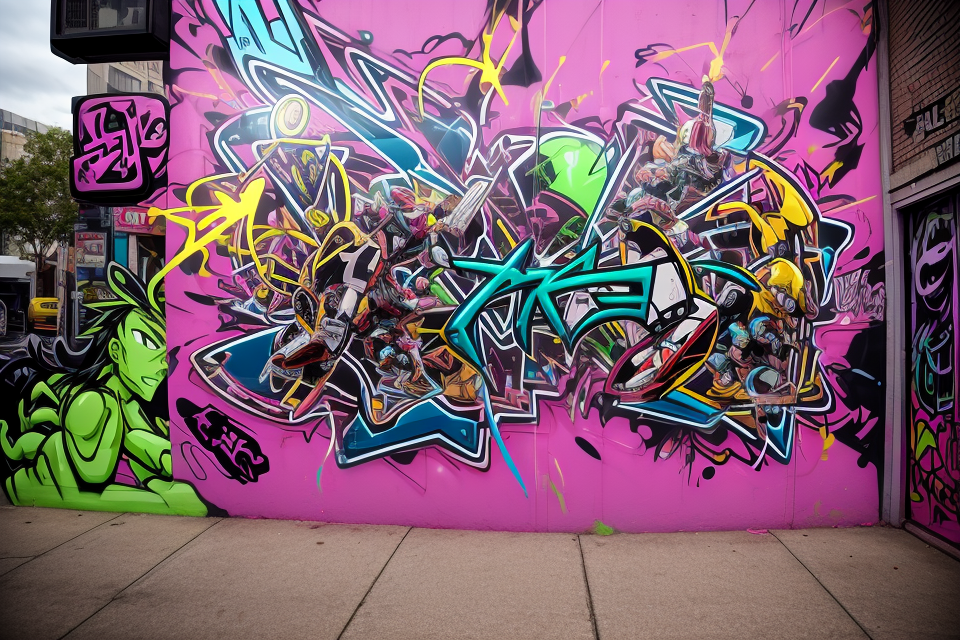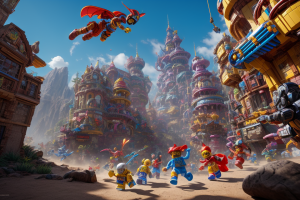
Bakugan is a term that is familiar to many, especially those who have grown up in the 21st century. But what exactly is Bakugan? Is it just another toy that has been created to capture the imagination of children, or is it something more? In this article, we will explore the origins of Bakugan, its place in the toy battles scene, and the factors that have contributed to its enduring popularity. Whether you are a fan of Bakugan or simply curious about this phenomenon, read on to discover the truth about this unique toy.
The Rise of Toy Battles
The Evolution of Toy Battles
Toy battles have been a part of human culture for centuries, with games such as chess and Stratego providing a means of entertainment and strategy. In the 20th century, the evolution of toy battles continued with the introduction of collectible card games such as Magic: The Gathering and Pokémon. These games allowed players to collect and trade cards representing different characters and abilities, which could be used to battle against opponents.
The transition to physical toys in the toy battles scene came with the release of the first action figures, such as G.I. Joe and Action Man, in the 1960s. These toys were designed to be used with a specific theme or storyline, and could be used to recreate battles and adventures in a physical form. The popularity of these toys led to the creation of entire worlds and universes, such as Star Wars and Transformers, which continue to be popular to this day.
In the late 1990s and early 2000s, the toy battles scene saw the rise of toys such as Beyblade and Tamagotchi, which introduced new mechanics and ways of playing. Beyblade, in particular, was a huge success, with its spinning tops and arena-based battles capturing the imagination of children and adults alike. This success led to the creation of numerous spin-offs and imitators, as well as the development of a professional competitive scene.
The evolution of toy battles has continued to the present day, with new games and toys constantly being released. The rise of technology has also played a major role in the evolution of toy battles, with digital games and apps providing new ways for players to battle and compete. The popularity of toy battles shows no signs of waning, and it remains a beloved part of many people’s childhoods and beyond.
The Popularity of Toy Battles
The popularity of toy battles games can be attributed to several factors. One of the most significant factors is the emergence of Pokémon, which became a global phenomenon in the late 1990s. The game’s concept of capturing and battling creatures with unique abilities and strengths captured the imagination of children and adults alike, leading to a surge in the popularity of toy battles games.
However, Pokémon was not the only game to capitalize on this trend. Other popular toy battles games, such as Beyblade and Yu-Gi-Oh!, also gained significant followings. These games required players to strategize and use their skills to defeat their opponents, making them both fun and challenging.
The popularity of toy battles games also transcended borders, becoming a global phenomenon. Children from different cultures and backgrounds could connect over their love for these games, leading to a sense of community and camaraderie.
Overall, the popularity of toy battles games is a testament to the human desire for competition, strategy, and fun. These games provide an outlet for individuals to engage in friendly competition while also honing their skills and strategic thinking.
Bakugan: A New Challenger Approaches
The Concept of Bakugan
Bakugan is a unique toy line that has captured the attention of children and collectors alike. It is a Japanese-based toy line that has become a worldwide phenomenon. The toys are characterized by their unique shape and design, which sets them apart from other toy lines.
The Origins of Bakugan
Bakugan was first introduced in 1998 by Sega Toys Co. Ltd. in Japan. The toy line was created by a team of designers and engineers who wanted to create a new type of toy that would combine elements of action figures and collectible cards. The name “Bakugan” is derived from the Japanese word “bakuhan,” which means “to explode” or “to fight.”
The Unique Characteristics of Bakugan Toys
Bakugan toys are small, spherical objects that are designed to be used in a battle game. They have a soft, squishy outer layer that is designed to be easily gripped by small hands. The toys are designed to be launched at a target, and the resulting impact triggers a hidden spring mechanism that causes the Bakugan to unfurl and reveal its design.
Each Bakugan toy is unique and has its own set of characteristics, such as its color, shape, and design. There are several different types of Bakugan toys, including standard Bakugan, Metal Bakugan, and Darkus Bakugan.
The Integration of Technology in Bakugan Gameplay
One of the unique features of Bakugan toys is their integration with technology. The toys are designed to be used in a battle game, and each Bakugan has a corresponding card that contains information about its attributes and abilities. Players can use these cards to strategize and build their Bakugan collections.
In addition to the cards, Bakugan toys are also designed to work with an online game called “Bakugan Battle Brawlers.” This game allows players to enter their Bakugan into virtual battles against other players from around the world. The outcome of each battle is determined by the attributes and abilities of the Bakugan and the strategy of the player.
Overall, the concept of Bakugan as a toy line is unique and innovative. Its integration with technology and its emphasis on strategy and collectibility make it a popular choice among children and collectors alike.
The Growth of Bakugan
The Success of the Bakugan Franchise
The Bakugan franchise, which was first introduced in 2008, has seen remarkable success in the toy industry. The franchise, which includes a range of collectible toys, a popular animated television series, and a trading card game, has captured the imagination of children and collectors alike.
The Popularity of Bakugan among Children and Collectors
Bakugan has become a beloved toy among children, who enjoy using the toys to engage in epic battles with their friends. The toys have also gained a significant following among collectors, who are drawn to the unique designs and high-quality construction of the Bakugan figures.
The Impact of Bakugan on the Toy Battles Scene
The rise of Bakugan has had a significant impact on the toy battles scene, which has traditionally been dominated by other popular toy lines such as Beyblade and Top Gear. Bakugan’s unique design and gameplay mechanics have set it apart from other toy battles lines, and have helped to establish it as a major player in the toy battles scene.
As a result of its success, Bakugan has inspired a new generation of children to take up toy battles, and has helped to keep the toy battles scene vibrant and dynamic. Whether you are a fan of Bakugan or simply a fan of toy battles, there is no denying that Bakugan has had a profound impact on the world of toys and has cemented its place as a beloved toy among children and collectors alike.
The Controversy Surrounding Bakugan
- Safety Concerns:
- Allegations of small parts posing choking hazards
- Complaints of toy designs leading to injuries during play
- Classification Debates:
- Disagreements over whether Bakugan qualifies as a traditional toy
- Discussions on whether its design and function differentiate it from other toys
- The Role of Regulation:
- Examination of the regulatory framework governing toy battles
- The impact of safety standards on the design and distribution of Bakugan toys
Bakugan: A New Challenger Approaches
The emergence of Bakugan in the toy battles scene has sparked intense debate and controversy. Concerns over safety, the classification of Bakugan as a toy, and the role of regulation in governing the activity have all come under scrutiny.
Safety Concerns
One of the primary concerns surrounding Bakugan is the potential safety risks associated with its design and components. Some critics argue that the small parts used in Bakugan toys pose a choking hazard to children, while others contend that the toys’ design can lead to injuries during play. These safety concerns have prompted some parents and advocacy groups to call for stricter regulations on the production and distribution of Bakugan toys.
Classification Debates
Another area of contention surrounding Bakugan is its classification as a toy. Some individuals assert that Bakugan does not fit the traditional definition of a toy, as it incorporates elements of strategy and competition that set it apart from other playthings. This debate has sparked discussions on whether Bakugan should be subject to the same regulatory standards as traditional toys or if it requires a unique framework to address its distinct characteristics.
The Role of Regulation
The lack of a clear regulatory framework governing toy battles has also been a source of controversy. Some argue that the absence of regulation has allowed Bakugan and other toy battling games to proliferate without adequate oversight, potentially putting children at risk. Others contend that excessive regulation could stifle innovation and creativity in the toy battles scene. As such, there is ongoing debate over the appropriate level of regulation necessary to ensure the safety and well-being of participants while allowing the activity to thrive.
Defining a Toy
The Nature of Toys
The history of toys
Toys have been a part of human culture for thousands of years, with evidence of toys dating back to ancient civilizations such as Egypt, Greece, and Rome. Early toys were often simple objects, such as stones, sticks, and balls, that were used for play and learning. As time passed, toys became more complex and diverse, reflecting the changing needs and interests of children and society.
The role of toys in child development
Toys play a crucial role in the development of children, as they provide opportunities for exploration, creativity, and learning. Through play, children can develop important skills such as problem-solving, imagination, and social interaction. Toys also help children make sense of the world around them, as they can represent and simulate real-life experiences and concepts.
The different types of toys
Toys can be categorized into several different types based on their purpose, materials, and intended audience. Some common types of toys include:
- Educational toys, which are designed to teach specific skills or concepts
- Construction toys, which allow children to build and create structures
- Dolls and action figures, which allow children to engage in imaginative play
- Puzzles and games, which challenge children’s problem-solving abilities
- Vehicles and playsets, which allow children to explore and create stories
- Art and craft toys, which encourage creativity and self-expression
Overall, toys are an important part of childhood and can have a significant impact on a child’s development.
The Criteria for a Toy
In order to determine whether Bakugan is a toy, it is essential to examine the criteria that define a toy. The following are the three primary criteria that can be used to classify an object as a toy:
- Physical attributes of toys
- The intended purpose of toys
-
The marketing and distribution of toys
-
Physical Attributes of Toys
A toy is typically defined by its physical attributes, such as its size, shape, and materials. Toys are often designed to be small, portable, and lightweight, making them easy for children to handle and carry around. Bakugan is no exception, as it is a small, handheld toy that can be easily carried around and played with. - The Intended Purpose of Toys
The intended purpose of a toy is another important factor in determining whether an object can be classified as a toy. Toys are typically designed to provide entertainment, education, or both. Bakugan is primarily designed for entertainment purposes, as it is a collectible toy that is used to play a game called “Bakugan Battle”. - The Marketing and Distribution of Toys
Toys are typically marketed and distributed to children and families through various channels, such as toy stores, department stores, and online retailers. Bakugan is marketed and distributed primarily to children and families, and it is available in a variety of retail outlets, including toy stores, department stores, and online retailers.
In conclusion, Bakugan meets all three criteria for a toy, as it has physical attributes that are characteristic of toys, it is intended for entertainment purposes, and it is marketed and distributed to children and families. Therefore, it can be classified as a toy.
The Battle for the Definition of a Toy
The Debate Over Bakugan’s Classification
- The arguments for and against Bakugan being considered a toy
- Proponents of Bakugan as a toy argue that it meets the traditional criteria for being classified as a plaything, including its intended use for recreational purposes and its ability to stimulate imagination and creativity in children.
- Opponents, however, contend that Bakugan’s unique combination of physical and digital elements sets it apart from traditional toys, making its classification as a toy unclear.
- The role of industry and consumer groups in the debate
- Industry groups, such as the Toy Industry Association, have been vocal in their support of Bakugan as a toy, citing its popularity and success in the marketplace as evidence of its toy status.
- Consumer groups, on the other hand, have raised concerns about the potential risks associated with Bakugan’s use, such as the possibility of injury or addiction, and have called for further regulation and oversight.
- The potential impact of a definitive classification on the toy battles scene
- A definitive classification of Bakugan as a toy could have significant implications for the toy battles scene, including the regulation of tournaments and competitions, the marketing and promotion of Bakugan products, and the overall perception of Bakugan within the toy industry.
- However, a lack of consensus on Bakugan’s classification may continue to create uncertainty and confusion for participants and stakeholders in the toy battles scene.
The Future of Toy Battles
- The potential for new toy battles games and franchises
- As technology continues to advance, there is a growing potential for new toy battles games and franchises to emerge. With the success of existing franchises such as Bakugan, there is a strong demand for new and innovative ways to engage in toy battles.
- One potential direction for the future of toy battles is the integration of virtual reality technology. This would allow players to physically battle their toys in a virtual environment, adding a new level of immersion and excitement to the game.
- Another potential direction is the development of new toy lines that incorporate advanced technology, such as robotics or artificial intelligence. This would allow for even more strategic gameplay, as players would need to consider the abilities and limitations of their toys when developing their battle strategies.
- The continued importance of strategy and skill in toy battles
- Despite the potential for new technologies and gameplay mechanics, the importance of strategy and skill in toy battles is likely to remain a constant factor. Players will still need to develop and execute effective battle plans, using their knowledge of their toys and their opponents’ toys to gain an advantage.
- As the toy battles scene continues to evolve, there may be a greater emphasis on mental and physical endurance, as players push themselves to their limits in order to emerge victorious.
- The evolving definition of a toy and its impact on the toy battles scene
- The definition of a toy is constantly evolving, as new technologies and materials are developed and integrated into toy design. This evolution is likely to have a significant impact on the toy battles scene, as players and manufacturers alike grapple with the question of what constitutes a “toy” in the first place.
- As the definition of a toy becomes more fluid and inclusive, there may be an increased focus on creativity and self-expression in toy battles. Players may be encouraged to use their toys in unique and unexpected ways, pushing the boundaries of what is considered “normal” or “acceptable” in the world of toy battles.
FAQs
1. What is Bakugan?
Bakugan is a brand of collectible, interactive toy that was first released in 2008. The toys are designed to be used in a game called Bakugan Battle Brawlers, in which players take turns activating their Bakugan toys and watching as they transform into a battle formation.
2. Is Bakugan a toy?
Yes, Bakugan is a toy. It is a collectible, interactive toy that is designed to be used in a game called Bakugan Battle Brawlers. The toys are sold in small, sealed packages and come in a variety of shapes, sizes, and colors.
3. What makes Bakugan different from other toys?
Bakugan is unique because it combines elements of both collectible toys and interactive games. The toys are designed to be collected and traded, like other collectible toys, but they also have a built-in gameplay element that makes them more interactive and engaging.
4. How do Bakugan toys work?
Bakugan toys work by being activated and then transforming into a battle formation. When a Bakugan is activated, it pops open and reveals a small character inside. The character is then placed onto a playing surface, where it transforms into a battle formation. Players take turns activating their Bakugan and trying to knock their opponents’ Bakugan off the playing surface.
5. Is Bakugan a popular toy?
Yes, Bakugan has been a popular toy since it was first released in 2008. It has a dedicated fan base and is still widely collected and played with today.







